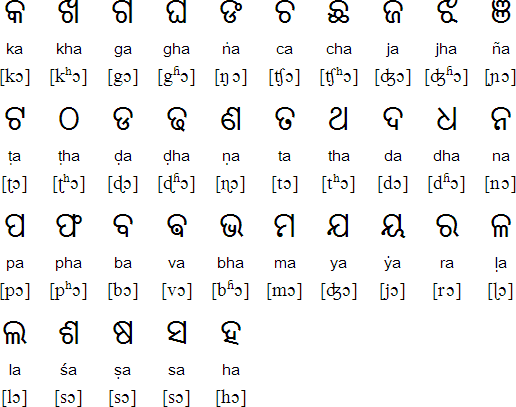Odia is an Indo-Aryan language spoken by about 40 million people mainly in the Indian state of Odisha, and also in parts of West Bengal, Jharkhand, Chhattisgarh and Andhra Pradesh. Odia is one of the many official languages of India. It is the official language of Odisha, and the second official language of Jharkhand. It is also designated as a Classical Language in India as it has a long literary history. Odia is closely related to Bengali and Assamese.
Odia is also known as Oriya, and Odisha as Orissa, however Odia and Odisha are now the preferred names in English as they are closer to their native names: ଓଡ଼ିଆ (oḍiā) [ɔɖiaː] and ଓଡ଼ିଶା (oḍiśā) [ɔɖisaː].
The Odia script developed from the Kalinga script, one of the many descendents of the Brahmi script of ancient India. The earliest known inscription in the Odia language, in the Kalinga script, dates from 1051.
The curved appearance of the Odia script is a result of the practice of writing on palm leaves, which have a tendency to tear if you use too many straight lines.




Download the Excel spreadsheet used to make these charts

Sabu manuṣẏa janmaukāḷaru svadhīna, ṣemānaṅkara marsẏāḍā o adhaikāra samāna, semānaṅaṭhāre prabã o bibeka naiha ṭachai, semāne paraspara paba brādahaba paiṣaṣa karai ṭhārpẏa jakairā ḍarakāra.
All human beings are born free and equal in dignity and rights. They are endowed with reason and conscience and should act towards one another in a spirit of brotherhood.
(Article 1 of the Universal Declaration of Human Rights)
ଶାଠ କହେ ଋତୁରେ ନଈ କଡ଼େ ଝଟା କି ଲଟାଟିଏ ଅହିରାଜ ଯଥା ଗଛରେ ଘର କରି ତା' ଦେହେ ମାତଇ ଆଉ ପ୍ରକୃତିରୁ ସକଳ ଜୀବନୀ ଖୋଜା ଊଣା ହେଲେ ଐକତାନେ ପଚା କଢ଼, ଫୁଲ ଓ ପତର-ଔଷଧୀ ଆହାର ଭରି ବଞ୍ଚେ ।
As we know that during the right season, on the bank of the river, a creeper would make a tree its home and grow over it like a krait, and when the nutrients from the nature fall short, the creeper feed on rotten buds, flowers and leaves making them its medicine.
ଈଶ୍ୱର ସାର କହୁଥିଲେ ଯେ "ପିରିୟଡ଼ିକ ଟେବୁଲ"ର ମଝିରେ ଥିବା ଯବକ୍ଷାରଜାନ ସପ୍ତମ ମୌଳିକ ଓ ଓଜନ ହେଉଛି ୧୫ରୁ ଊଣା ଆଉ ଏ ଋକ୍ଷ ବାଷ୍ପଟି ଶଲ୍ୟ ଚିକିତ୍ସାର ନିଶ୍ଚେତକଠାରୁ ହୃଦ୍ରୋଗ ପାଇଁ ଔଷଧ, କ୍ଷେପଣାସ୍ତ୍ରର ଶକ୍ତିକୋଷ, ଥଣ୍ଡା ଫ୍ରିଜରର ଐକୀକ ଘଟକ, ଖାଦ୍ୟ ନ ସଢ଼ିବା ଭଳି ପ୍ୟାକେଜିଂ ତିଆରିରେ ଲାଗେ
Nitrogen is the seventh element of periodic table and has a mass of 14. Its existence ranges from anesthesia for surgery to medicine for cardiac diseases, missile energy, basic part of a freezing unit and preservative to prevent spoiling of food.
ଅଳି, ଆଜ ଇତର ଈଶାଣ ଉପାସନା ଊହି ଏକା ଐଛିଣି ଓଗାଳୁଁ ଔଷଧିନାଶନ କାମ ଖମଣି ଗଲାରୁ ଘୁଙ୍ଗୁର ନାଦରେ ଚମକାଇ, ଛଇଳାଙ୍କୁ ଜ୍ୱାଳାରେ ଝଞ୍ଜାଇ, ନିଜ ଟମକ ଠାଣିରେ ଡରାଇ, ଢାଳେ ଅପାଙ୍ଗରେ ତର ଥରାଇ, ଦୁଃଖ ଧନ ନେଇ, ପରମାଦ ଫଜିତ ବ୍ୟାଜ ଭାବେ ମଣି ଯୋଷାଙ୍କୁ ରସିକ ଲୀଳାରେ ବନ୍ଧାଇ ଶ୍ୟାମ ଷଟପଦ ସନ୍ନିଧେ ହଜାଇ କ୍ଷନ୍ଦିଲା ।
O Cuckoo! Today, in this place, when I thought of worshipping Shiva(1) and invoking him as I sat alone, that destroyer-of-all-remedies, Cupid came. As the sun went away (that is, night descended) Cupid devised various ways [to torture] poor ladies. [He] surprises them with the jingle of his anklets, burns them in the fire [of passion] and frightens them with the beat of his drum. [Again, he] makes them shiver with his sidelong glance. [He] takes their sadness (2) as debt, and to return more grief as a despised form of interest, he entangles them in the tricks of the playful bee-like Krishna by leaving them at his feet.
(1) Worshipping Shiva is believed to help one get his/her beloved.
(2) Due to the absence of their beloved ones.
Information about Odia | Phrases | Numbers | Tower of Babel
Information about the Odia language
http://en.wikipedia.org/wiki/Odia_language
http://en.wikipedia.org/wiki/Odia_alphabet
http://www.orissadiary.com/orissa_profile/orissalanguage.asp
Odia lessons
http://learnoriya.blogspot.co.uk/
Odia phrases
http://wikitravel.org/en/Odia_phrasebook
http://www.mikecook.com/phrase/oriya.html
Odia dictionary
http://dictionary.tamilcube.com/oriya-dictionary.aspx
http://www.freelang.net/online/oriya.php
Odia fonts
http://www.wazu.jp/gallery/Fonts_Oriya.html
Type in Odia online
http://www.google.com/transliterate/oriya
http://www.bhashaindia.com/ilit/Oriya.aspx
Odia Unicode convertors
https://goo.gl/CmCF1q
Odia news
http://www.thesamaja.com
Awadhi, Assamese, Bagri, Bengali, Bhili, Bishnupriya Manipuri, Braj, Chakma, Chhattisgarhi, Chittagonian, Desiya, Dhatki, Dhivehi, Dhundari, Fiji Hindi, Gawar Bati, Gujarati, Hajong, Halbi, Haryanvi, Hindi, Hindko, Kannauji, Khandeshi, Konkani, Kotia, Kumaoni, Kutchi, Lambadi, Marathi, Marwari, Mewari, Modi, Nimadi, Noakhailla, Odia, Parkari Koli, Punjabi, Rajasthani, Rajbanshi, Rangpuri, Rohingya, Saraiki, Sarnámi Hindustani, Sindhi, Sinhala, Sourashtra, Sugali, Sylheti, Tanchangya, Urdu
Ahom, Aima, Arleng, Badagu, Badlit, Basahan, Balinese, Balti-A, Balti-B, Batak, Baybayin, Bengali, Bhaiksuki, Bhujimol, Bilang-bilang, Bima, Blackfoot, Brahmi, Buhid, Burmese, Carrier, Chakma, Cham, Cree, Dehong Dai, Devanagari, Dham Lipi, Dhankari / Sirmauri, Ditema, Dives Akuru, Dogra, Ethiopic, Evēla Akuru, Fox, Fraser, Gond, Goykanadi, Grantha, Gujarati, Gunjala Gondi, Gupta, Gurmukhi, Halbi Lipi, Hanifi, Hanuno'o, Hočąk, Ibalnan, Incung, Inuktitut, Jaunsari Takri, Javanese, Kaithi, Kadamba, Kamarupi, Kannada, Kawi, Kharosthi, Khema, Khe Prih, Khmer, Khojki, Khudabadi, Kirat Rai, Kōchi, Kodava Lipi, Komering, Kulitan, Kurukh Banna, Lampung, Lanna, Lao, Lepcha, Limbu, Lontara/Makasar, Lota Ende, Magar Akkha, Mahajani, Malayalam, Meitei (Modern), Manpuri (Old), Marchen, Meetei Yelhou Mayek, Meroïtic, Masarm Gondi, Modi, Mon, Mongolian Horizontal Square Script, Multani, Nandinagari, Newa, New Tai Lue, Ojibwe, Odia, Ogan, Pahawh Hmong, Pallava, Phags-pa, Purva Licchavi, Qiang / Rma, Ranjana, Rejang (Kaganga), Sasak, Savara, Satera Jontal, Shan, Sharda, Sheek Bakrii Saphaloo, Siddham, Sinhala, Sorang Sompeng, Sourashtra, Soyombo, Sukhothai, Sundanese, Syloti Nagri, Tagbanwa, Tai Noi, Takri, Tamil, Tanchangya (Ka-Pat), Tani, Thaana, Telugu, Thai, Tibetan, Tigalari, Tikamuli, Tocharian, Tolong Siki, Vatteluttu, Warang Citi
[top]
You can support this site by Buying Me A Coffee, and if you like what you see on this page, you can use the buttons below to share it with people you know.

If you like this site and find it useful, you can support it by making a donation via PayPal or Patreon, or by contributing in other ways. Omniglot is how I make my living.
Note: all links on this site to Amazon.com, Amazon.co.uk
and Amazon.fr
are affiliate links. This means I earn a commission if you click on any of them and buy something. So by clicking on these links you can help to support this site.
[top]